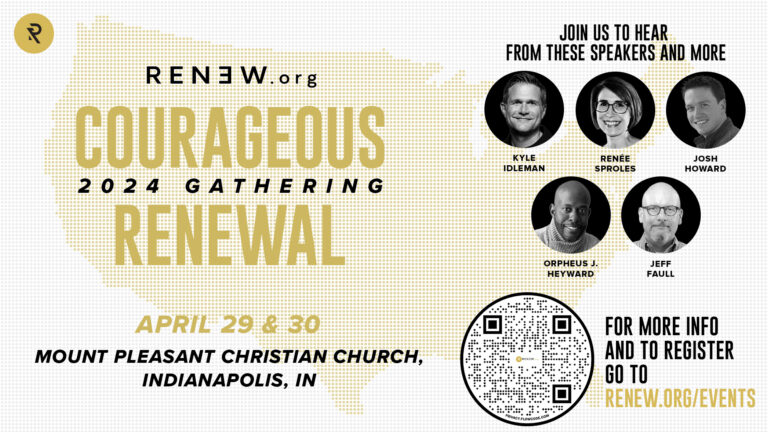*Editor’s Note: This is the first article in a 13-part series on the Beatitudes. Here’s the complete list of articles in the series:
- Who Does Jesus Think He Is?
- Crowds or Disciples?
- The Sermon’s Most Important Word
- The Pursuit of Happiness
- Poor in Spirit
- God’s Answer to the Problem of Evil
- Meekness
- Hunger and Thirst
- Mercy or the Mob
- Pure in Heart
- Peacemakers
- The Persecuted
- 7 Questions to Ask of Each Beatitude
The most important thing about the Sermon on the Mount is Jesus himself. We may be so numbed by “Sunday school answers,” that we may actually miss this. Jesus’ audience didn’t. After Jesus is done and they walk home trying to process what they just experienced, their main takeaway has to do with the man himself. He spoke with authority (Mt. 7:28-29).
When someone speaks “with authority,” it means that their words carry more weight because of who they are. “Oh. If that guy says it, then I need to stop and pay attention.”
So who is this guy? Again, it might be easy to miss, but the Sermon on the Mount says a lot about who Jesus is.
We’re familiar with the great Christological statements of, say, John–that Jesus is the divine Word made flesh (Jn. 1:1-14). Or maybe Paul’s statements that Jesus is “before all things, and in him all things hold together” (Col. 1:17). In him, “All the fullness of the Deity lives in bodily form” (Col. 2:9).
These were written to largely Graeco-Roman audiences. Maybe, as children of Western Civilization, they resonate with us because we still have some of that Graeco-Roman thought in our cultural DNA.
Matthew’s (and Jesus’) audience didn’t. Matthew is, by far, the most Jewish of all the gospels. It’s so Hebraic in thought and language that some scholars have toyed with the idea that Matthew actually wrote it in Hebrew first.
In the Sermon on the Mount, Matthew is painting a picture of Jesus using a distinctly Jewish color palette. We need to see it through that lens.
First, and most simply of all, when Jesus walks up a hill and sits down, his disciples automatically come and sit at his feet (5:1-2). His body language is using grammar they know quite well. When a Rabbi is ready to teach, he sits. It’s the equivalent of walking up to a podium and clearing your throat. So Jesus is clearly posturing himself as a teacher.
But that barely even scratches the surface. In verse 1 of his gospel, Matthew introduces Jesus as the Messiah–the anointed leader of God’s people. The ancient world tended to think collectively. They focused on the group more than the individual. So, in Old Testament thought, there is a sense in which the leader stands in the place of the entire community. He is the people.
One place you can see this is in the sin offering. If the high priest (an anointed leader of God’s people) sins, he brings guilt on all the people, and the required offering is a bull–the same offering that’s required if the entire community sins (Lev. 4:3-4, 13-14).
In that case, a good Jewish audience would grasp, almost without explanation, that, as Messiah, Jesus himself embodies the nation.
That’s what leaders do. How much more the Messiah? So nearly everything Matthew writes leading up to the Sermon on the Mount shows Jesus recapitulating the history of Israel in his own life.
- Israel (Jacob) was the miraculous child of a promise. Jesus is the miraculous child of a promise (Mt. 1:18-23).
- Israel went down to Egypt. Jesus goes down to Egypt (Mt. 2:13-14).
- Israel came up out of Egypt. Jesus comes up out of Egypt (Mt. 2:15, 19).
- Israel went through the water. Jesus goes through the water (Mt. 3:13-15).
- Israel went through the wilderness. Jesus goes through the wilderness (4:1-11).
This probably explains why, if you go back and read the Old Testament passages Matthew quotes in these chapters, many don’t seem to be predicting anything. They’re just talking about Israel’s history. That’s the point. Jesus fulfills them because he is Israel.
Moreover, unlike Israel in the Old Testament story, Jesus is doing it right.
You see this most clearly in Jesus’ time in the wilderness. He is tempted, just like the Israelites were in their wilderness. But, where they failed, Jesus stays faithful. He sticks to the plan.
Now think about this: You’re Jewish. The story of Israel is your cultural heritage, and you just read four chapters of Jesus recapitulating that story right up to Israel’s time in the wilderness. And then Jesus walks up a mountain and starts teaching.
There is no way you’re not going to think of Moses, Sinai, and the giving of the Law.
That’s the next part of Israel’s story. At this point, many commentators say that Matthew is portraying Jesus as a new Moses. That’s not wrong, but it’s not nearly enough. Of course he’s the new Moses! He’s everything!
But we need to take it farther. When Moses goes up the mountain, he’s not the one talking. He’s the one listening.
Jesus is not the one listening in the Sermon on the Mount.
If the picture of Jesus in Matthew 5 mirrors Mt. Sinai, it’s not clear that Jesus is standing in the place of Moses. Yes, Jesus is “the prophet” like Moses who was to come (Deut. 18:18). But the prophets punctuated all their oracles with the signature phrase, “Thus says the Lord.”
In the Sermon on the Mount, Jesus isn’t even acting merely like a prophet. He doesn’t say, “Thus says the Lord.” His signature phrase is, “But I tell you. . .”
No, in this recapitulation of the Sinai story, Jesus is the one at the top of the mountain speaking down. Jesus is acting as the very Voice of God. He is the voice from the mountain. And so John may not have a corner on “high Christology” when he depicts Jesus as the “Word of God.” In a distinctly Hebrew way, Matthew is saying almost exactly the same thing!
And so, at the end of the sermon, Jesus talks about “that day” (Mt. 7:21-23). “That day” is prophetic shorthand for “the day of the LORD.” Judgment day. The great day when God will vindicate his people, settle all accounts, and put things right. And Jesus assumes, without argument or explanation, that on the Great Day of the LORD, He is the Judge.
Teacher, Messiah, Prophet, the very voice of God. One could hardly paint a larger picture of who Jesus is.
But we can add one more brush stroke. Parallelism is the defining feature of Hebrew poetry (which a great deal of the Sermon on the Mount is). At the end of the Beatitudes, Jesus blesses those people who are persecuted “because of righteousness” (Mt. 5:10). But in the very next verse, when he stops to comment on this more, he says that his followers are blessed when they are persecuted “because of me.” Jesus parallels himself with righteousness itself.
One of my professors was talking with a Rabbi and asked him why he didn’t accept Jesus as Messiah. The Rabbi said it was because, if you take Jesus’ words seriously, he is claiming to be Torah. That claim would, of course, be absolutely unacceptable.
Unless it’s true.
Jesus’ audience walks away stunned (“shell-shocked” would actually be a surprisingly accurate
translation), not because they just heard a bunch of pretty words, but because, in those words, in this Word, they just encountered the God of the universe. The most important thing about the Sermon on the Mount is not what it’s about but who it’s about. Because the Sermon on the Mount is, at its very core, an invitation into the very heart of God.











